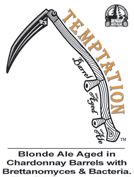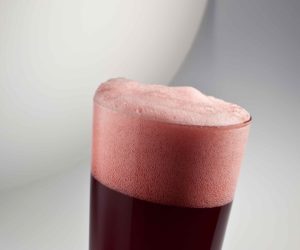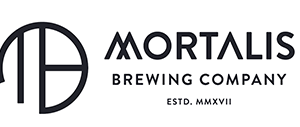Russian River Brewing Co. Temptation clone
Russian River Brewing Co. Temptation clone
(5 gallons/19 L, all-grain)
OG = 1.062 FG = 1.012 (going into the barrel)
IBU = 28 SRM = 4 ABV = 6.8%
Both the ABV and final gravity of Temptation are based on the beer aging in the barrel prior to the souring process. Owner and brewer Vinnie Cilurzo says, “None of our barrel beers are easy to replicate on a homebrew level, as we are matching specific recipes with specific types of wine barrels. For example, Temptation is aged in Chardonnay barrels exclusively. One suggestion for a homebrewer is to add a little bit of Chardonnay into the beer to get the wine character since they cannot get it from the wood like we do.”
Ingredients
11.5 lb. (5.2 kg) 2-row pale malt
10 oz. (0.27 kg) acidulated malt
14 oz. (0.41 kg) dextrin malt
6 AAU Warrior hops (90 mins.) (0.4 oz./11 g of 15.0% alpha acids)
1.8 AAU Styrian Goldings hops (30 mins.) (0.4 oz./11 g of 4.5% alpha acids)
1.4 AAU Styrian Goldings hops (0 mins.) (0.3 oz./8.5 g of 4.5% alpha acids)
White Labs WLP530 (Abbey Ale) or Wyeast 1214 (Belgian Abbey) yeast
Wyeast 5112 (Brettanomyces bruxellensis) or White Labs WLP650 (Brettanomyces bruxellensis) yeast
Wyeast 5335 (Lactobacillus), White Labs WLP677 (Lactobacillus), or Wyeast 5733 (Pediococcus) bacteria
1 cup (200 g) dextrose (for priming)
Oak barrel, staves, beans or chips
Chardonnay (optional)
Step by Step
Mash the grains at 158°F (70°C). Boil for 90 minutes, adding the hops at the times indicated. Pitch the ale or abbey yeast and begin fermentation at 68°F (20°C) and let it free rise to 76°F (24°C). After primary fermentation, drop as much of the yeast out as possible and move the beer to a wine barrel or secondary fermenter (with oak alternative) where Brettanomyces is added. After 8 to 12 weeks of aging with the Brett, add bacteria to beer and top the barrel/fermenter with a neutral base beer or Chardonnay. From here, the beer will sit for another 6 to 9 months. After the barrel aging is complete, bottle condition the beer using a wine yeast (such as Scott Labs RP15) and an appropriate quantity of priming sugar to meet your desired CO2 level (around 3.2 volumes of CO2). High-pressure-rated bottles are strongly suggested.
Extract with grains option:
Substitute 6.6 pounds (3 kg) light liquid malt extract and 1.75 pounds (0.8 kg) light dried malt extract for the 2-row pale malt. Omit the acidulated malt and dextrin malt and add 0.25 ounces (8 mL) 88 percent lactic acid. Add 5 gallons (19 L) water, extract, and lactic acid to the kettle, being sure to add the liquid malt extract off heat to avoid scorching the clumped extract. Follow the remaining portion of the all-grain recipe.
Poor Man’s Barrel Option:
Don’t have the budget (or room) for a barrel? Try this “poor man’s” method of emulating some of the aspects of barrel aging. Conduct your primary fermentation in a bucket or ferment the beer with ale yeast, then rack it to a bucket — adding any “bugs” that may be called for. Buckets are more permeable to oxygen than barrels are, so let the beer condition in the bucket for only about 3 months, then rack it to a carboy for the remaining conditioning time. Two weeks before racking, take 3.0 oz. (85 g) of oak cubes (French oak, medium toast) and soak them in wine. Use Chardonnay for the Temptation clone, Pinot Noir for La Roja, Cabernet Sauvignon for Darth Porter and Burgundy or Meritage for Grand Cru and La Folie. Change wine every 3 days to lessen the intensity of the new oak. Add cubes when beer is racked to carboy.
Written by BYO Staff

A Belgian-styled blonde ale aged on oak with Brett added. "When we fill the used Chardonnay barrels, we only add Brettanomyces in with the beer as we are filling the barrels. The acidity comes from the bacteria that are floating around our barrel room. To achieve the acidity as a homebrewer, you’ll need to add some Lacto and Pedio."
— Vinnie Cilurzo



